ACC620 Research Project: Agency Theory and Carbon Emission Analysis
VerifiedAdded on 2023/06/13
|9
|1827
|360
Report
AI Summary
This research proposal for ACC620 Contemporary Issues in Accounting explores the relationship between agency theory and carbon emission rates, focusing on the role of CDP (Carbon Disclosure Project) data. It summarizes relevant literature, proposing that the agent (CPD) influences the principal (other companies) to reduce carbon emissions. The proposal presents a conceptual model with CPD data as the independent variable and carbon emission rate as the dependent variable, formulating hypotheses to test the relationship. It outlines a research methodology employing positivism, a deductive approach, mixed research design, and probability sampling to analyze primary and secondary data. The proposal includes a time plan for completing the research and references supporting the theoretical framework.
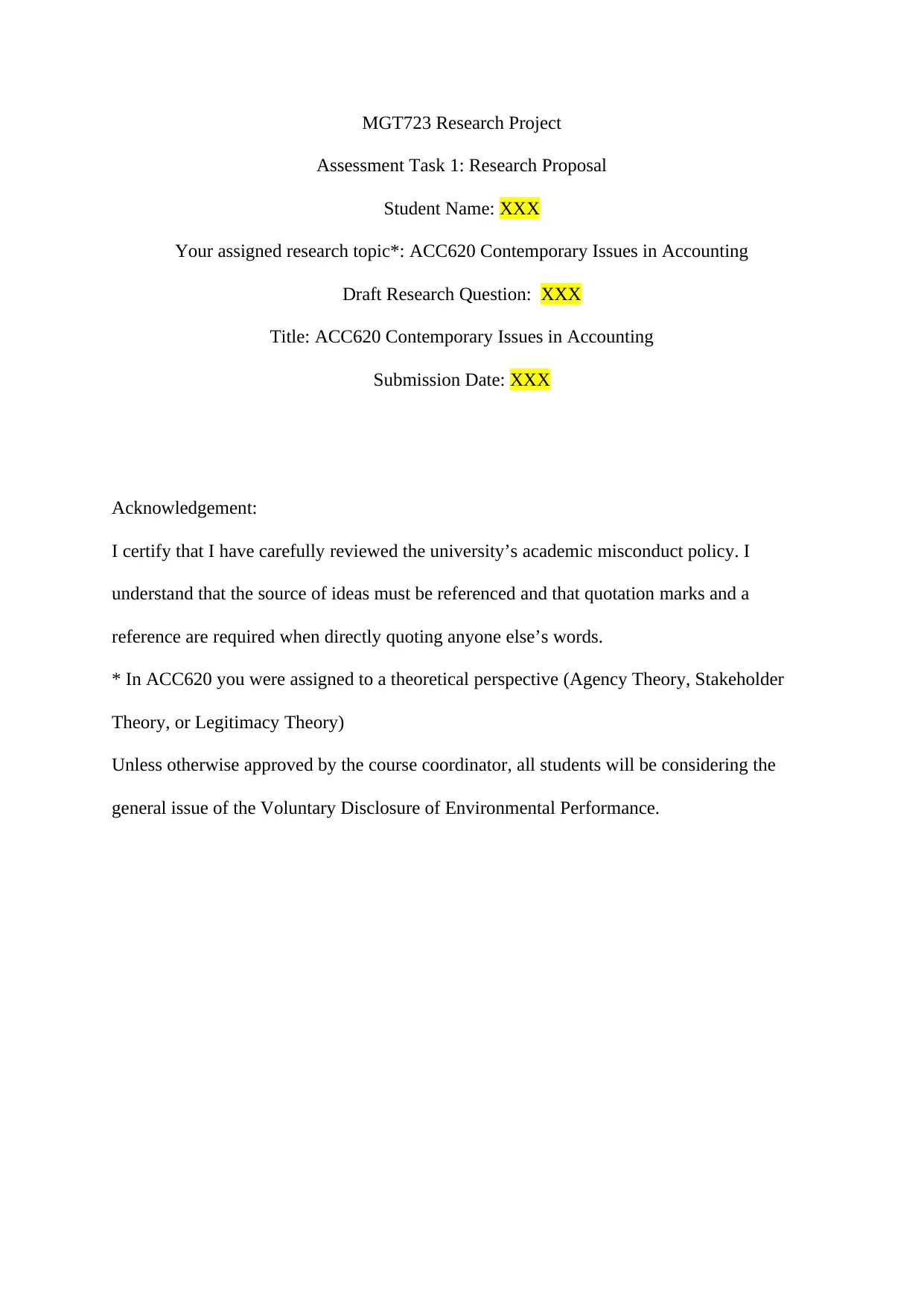
MGT723 Research Project
Assessment Task 1: Research Proposal
Student Name: XXX
Your assigned research topic*: ACC620 Contemporary Issues in Accounting
Draft Research Question: XXX
Title: ACC620 Contemporary Issues in Accounting
Submission Date: XXX
Acknowledgement:
I certify that I have carefully reviewed the university’s academic misconduct policy. I
understand that the source of ideas must be referenced and that quotation marks and a
reference are required when directly quoting anyone else’s words.
* In ACC620 you were assigned to a theoretical perspective (Agency Theory, Stakeholder
Theory, or Legitimacy Theory)
Unless otherwise approved by the course coordinator, all students will be considering the
general issue of the Voluntary Disclosure of Environmental Performance.
Assessment Task 1: Research Proposal
Student Name: XXX
Your assigned research topic*: ACC620 Contemporary Issues in Accounting
Draft Research Question: XXX
Title: ACC620 Contemporary Issues in Accounting
Submission Date: XXX
Acknowledgement:
I certify that I have carefully reviewed the university’s academic misconduct policy. I
understand that the source of ideas must be referenced and that quotation marks and a
reference are required when directly quoting anyone else’s words.
* In ACC620 you were assigned to a theoretical perspective (Agency Theory, Stakeholder
Theory, or Legitimacy Theory)
Unless otherwise approved by the course coordinator, all students will be considering the
general issue of the Voluntary Disclosure of Environmental Performance.
Paraphrase This Document
Need a fresh take? Get an instant paraphrase of this document with our AI Paraphraser
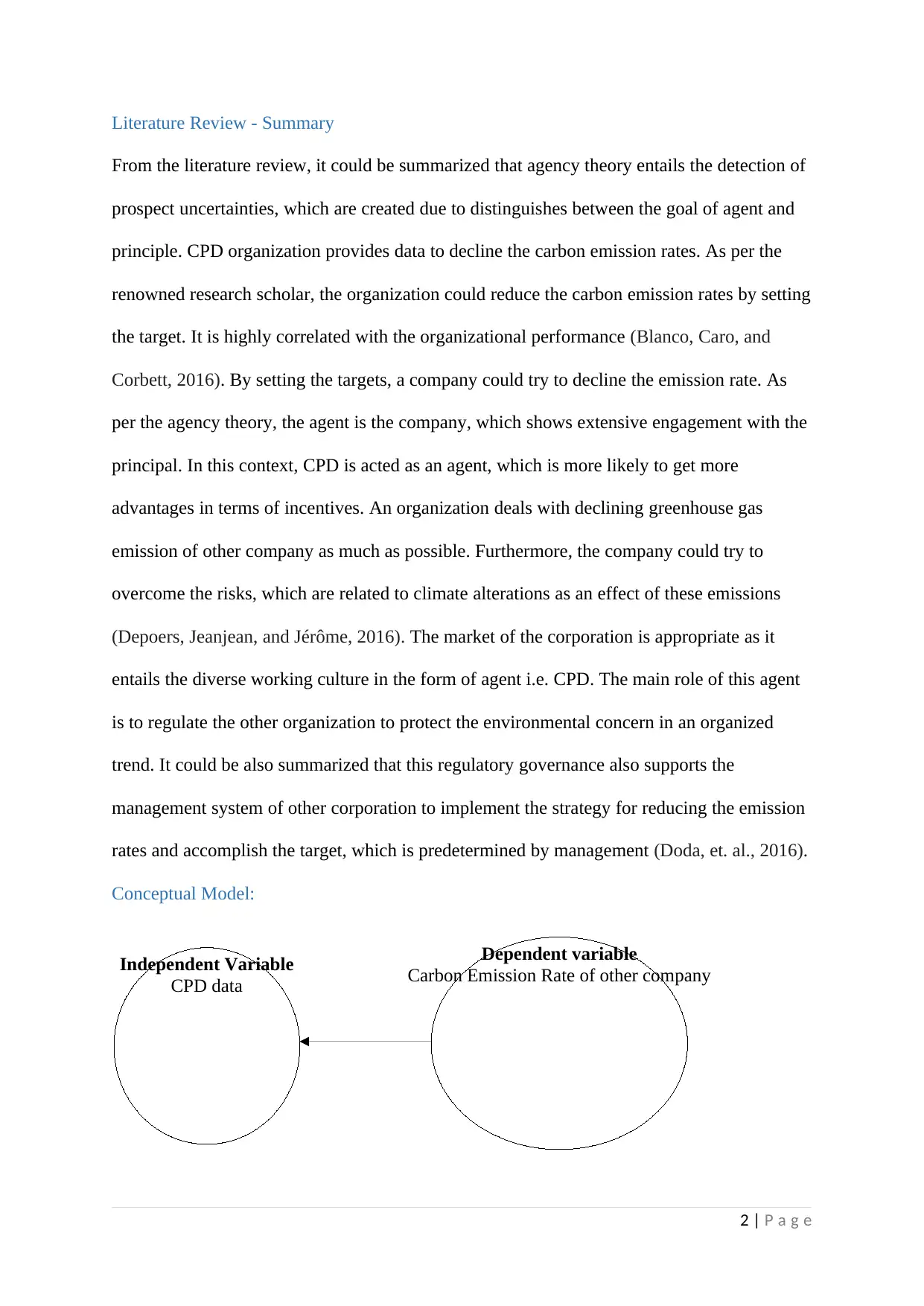
Independent Variable
CPD data
Dependent variable
Carbon Emission Rate of other company
Literature Review - Summary
From the literature review, it could be summarized that agency theory entails the detection of
prospect uncertainties, which are created due to distinguishes between the goal of agent and
principle. CPD organization provides data to decline the carbon emission rates. As per the
renowned research scholar, the organization could reduce the carbon emission rates by setting
the target. It is highly correlated with the organizational performance (Blanco, Caro, and
Corbett, 2016). By setting the targets, a company could try to decline the emission rate. As
per the agency theory, the agent is the company, which shows extensive engagement with the
principal. In this context, CPD is acted as an agent, which is more likely to get more
advantages in terms of incentives. An organization deals with declining greenhouse gas
emission of other company as much as possible. Furthermore, the company could try to
overcome the risks, which are related to climate alterations as an effect of these emissions
(Depoers, Jeanjean, and Jérôme, 2016). The market of the corporation is appropriate as it
entails the diverse working culture in the form of agent i.e. CPD. The main role of this agent
is to regulate the other organization to protect the environmental concern in an organized
trend. It could be also summarized that this regulatory governance also supports the
management system of other corporation to implement the strategy for reducing the emission
rates and accomplish the target, which is predetermined by management (Doda, et. al., 2016).
Conceptual Model:
2 | P a g e
CPD data
Dependent variable
Carbon Emission Rate of other company
Literature Review - Summary
From the literature review, it could be summarized that agency theory entails the detection of
prospect uncertainties, which are created due to distinguishes between the goal of agent and
principle. CPD organization provides data to decline the carbon emission rates. As per the
renowned research scholar, the organization could reduce the carbon emission rates by setting
the target. It is highly correlated with the organizational performance (Blanco, Caro, and
Corbett, 2016). By setting the targets, a company could try to decline the emission rate. As
per the agency theory, the agent is the company, which shows extensive engagement with the
principal. In this context, CPD is acted as an agent, which is more likely to get more
advantages in terms of incentives. An organization deals with declining greenhouse gas
emission of other company as much as possible. Furthermore, the company could try to
overcome the risks, which are related to climate alterations as an effect of these emissions
(Depoers, Jeanjean, and Jérôme, 2016). The market of the corporation is appropriate as it
entails the diverse working culture in the form of agent i.e. CPD. The main role of this agent
is to regulate the other organization to protect the environmental concern in an organized
trend. It could be also summarized that this regulatory governance also supports the
management system of other corporation to implement the strategy for reducing the emission
rates and accomplish the target, which is predetermined by management (Doda, et. al., 2016).
Conceptual Model:
2 | P a g e
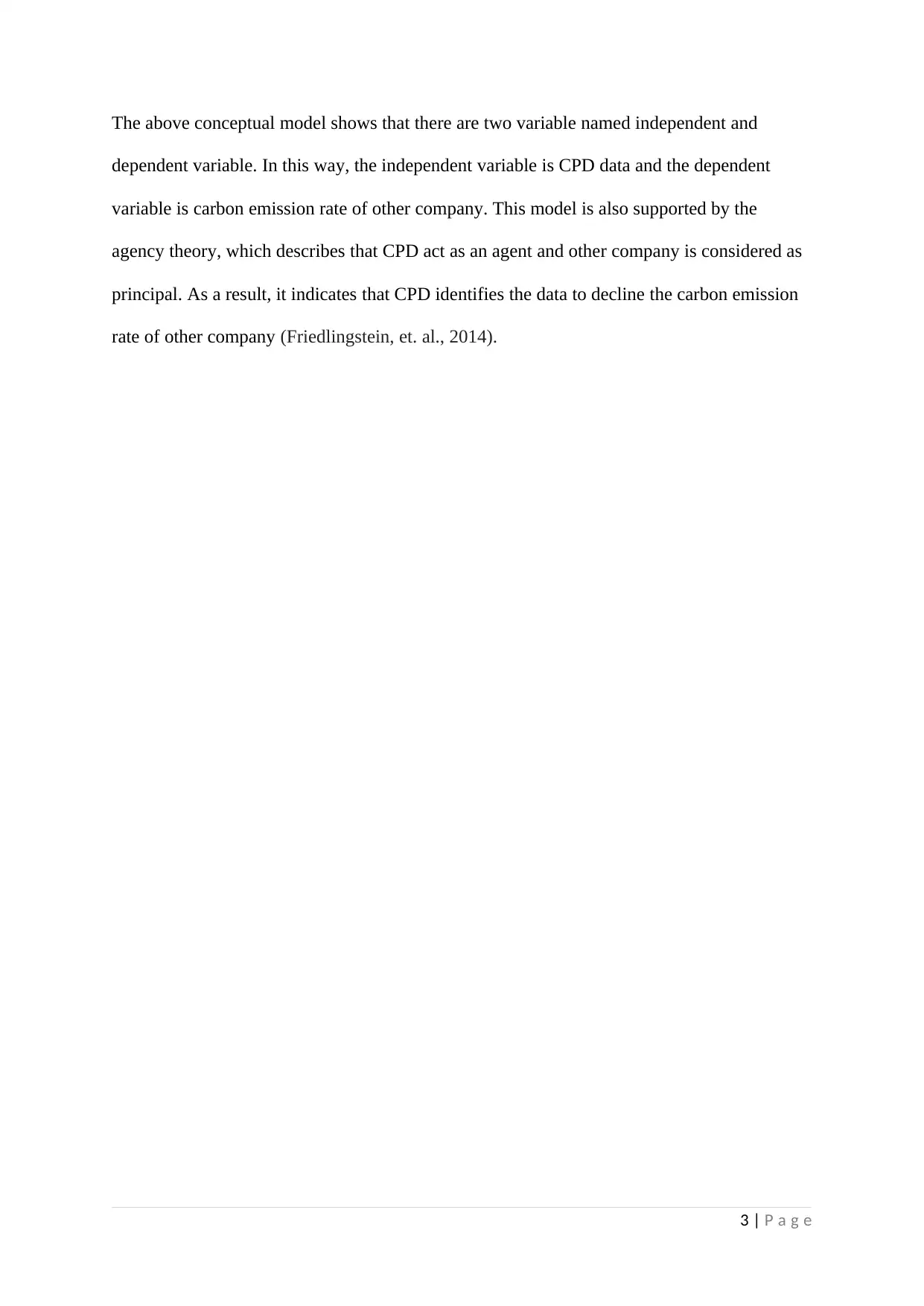
The above conceptual model shows that there are two variable named independent and
dependent variable. In this way, the independent variable is CPD data and the dependent
variable is carbon emission rate of other company. This model is also supported by the
agency theory, which describes that CPD act as an agent and other company is considered as
principal. As a result, it indicates that CPD identifies the data to decline the carbon emission
rate of other company (Friedlingstein, et. al., 2014).
3 | P a g e
dependent variable. In this way, the independent variable is CPD data and the dependent
variable is carbon emission rate of other company. This model is also supported by the
agency theory, which describes that CPD act as an agent and other company is considered as
principal. As a result, it indicates that CPD identifies the data to decline the carbon emission
rate of other company (Friedlingstein, et. al., 2014).
3 | P a g e
⊘ This is a preview!⊘
Do you want full access?
Subscribe today to unlock all pages.

Trusted by 1+ million students worldwide
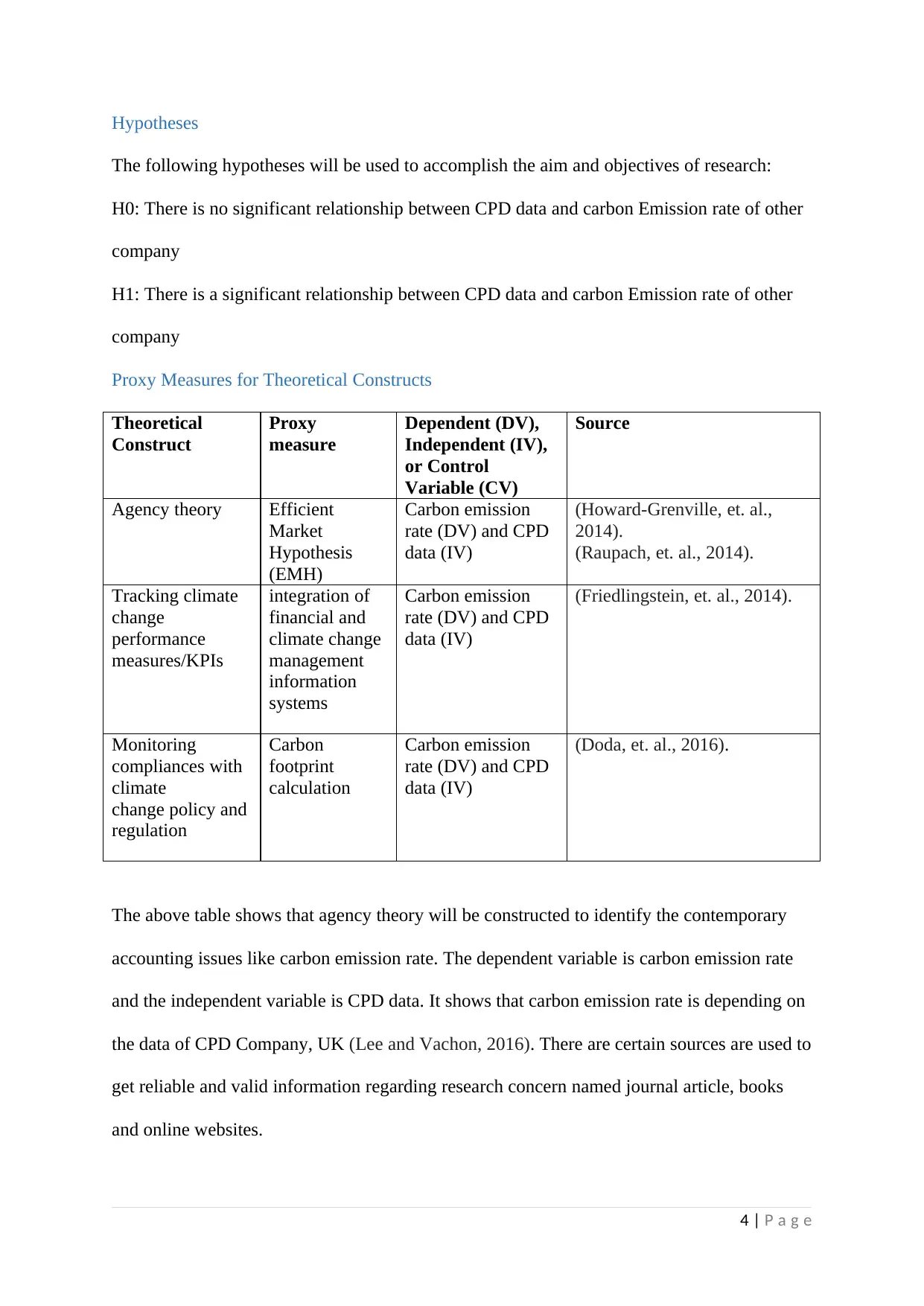
Hypotheses
The following hypotheses will be used to accomplish the aim and objectives of research:
H0: There is no significant relationship between CPD data and carbon Emission rate of other
company
H1: There is a significant relationship between CPD data and carbon Emission rate of other
company
Proxy Measures for Theoretical Constructs
Theoretical
Construct
Proxy
measure
Dependent (DV),
Independent (IV),
or Control
Variable (CV)
Source
Agency theory Efficient
Market
Hypothesis
(EMH)
Carbon emission
rate (DV) and CPD
data (IV)
(Howard-Grenville, et. al.,
2014).
(Raupach, et. al., 2014).
Tracking climate
change
performance
measures/KPIs
integration of
financial and
climate change
management
information
systems
Carbon emission
rate (DV) and CPD
data (IV)
(Friedlingstein, et. al., 2014).
Monitoring
compliances with
climate
change policy and
regulation
Carbon
footprint
calculation
Carbon emission
rate (DV) and CPD
data (IV)
(Doda, et. al., 2016).
The above table shows that agency theory will be constructed to identify the contemporary
accounting issues like carbon emission rate. The dependent variable is carbon emission rate
and the independent variable is CPD data. It shows that carbon emission rate is depending on
the data of CPD Company, UK (Lee and Vachon, 2016). There are certain sources are used to
get reliable and valid information regarding research concern named journal article, books
and online websites.
4 | P a g e
The following hypotheses will be used to accomplish the aim and objectives of research:
H0: There is no significant relationship between CPD data and carbon Emission rate of other
company
H1: There is a significant relationship between CPD data and carbon Emission rate of other
company
Proxy Measures for Theoretical Constructs
Theoretical
Construct
Proxy
measure
Dependent (DV),
Independent (IV),
or Control
Variable (CV)
Source
Agency theory Efficient
Market
Hypothesis
(EMH)
Carbon emission
rate (DV) and CPD
data (IV)
(Howard-Grenville, et. al.,
2014).
(Raupach, et. al., 2014).
Tracking climate
change
performance
measures/KPIs
integration of
financial and
climate change
management
information
systems
Carbon emission
rate (DV) and CPD
data (IV)
(Friedlingstein, et. al., 2014).
Monitoring
compliances with
climate
change policy and
regulation
Carbon
footprint
calculation
Carbon emission
rate (DV) and CPD
data (IV)
(Doda, et. al., 2016).
The above table shows that agency theory will be constructed to identify the contemporary
accounting issues like carbon emission rate. The dependent variable is carbon emission rate
and the independent variable is CPD data. It shows that carbon emission rate is depending on
the data of CPD Company, UK (Lee and Vachon, 2016). There are certain sources are used to
get reliable and valid information regarding research concern named journal article, books
and online websites.
4 | P a g e
Paraphrase This Document
Need a fresh take? Get an instant paraphrase of this document with our AI Paraphraser
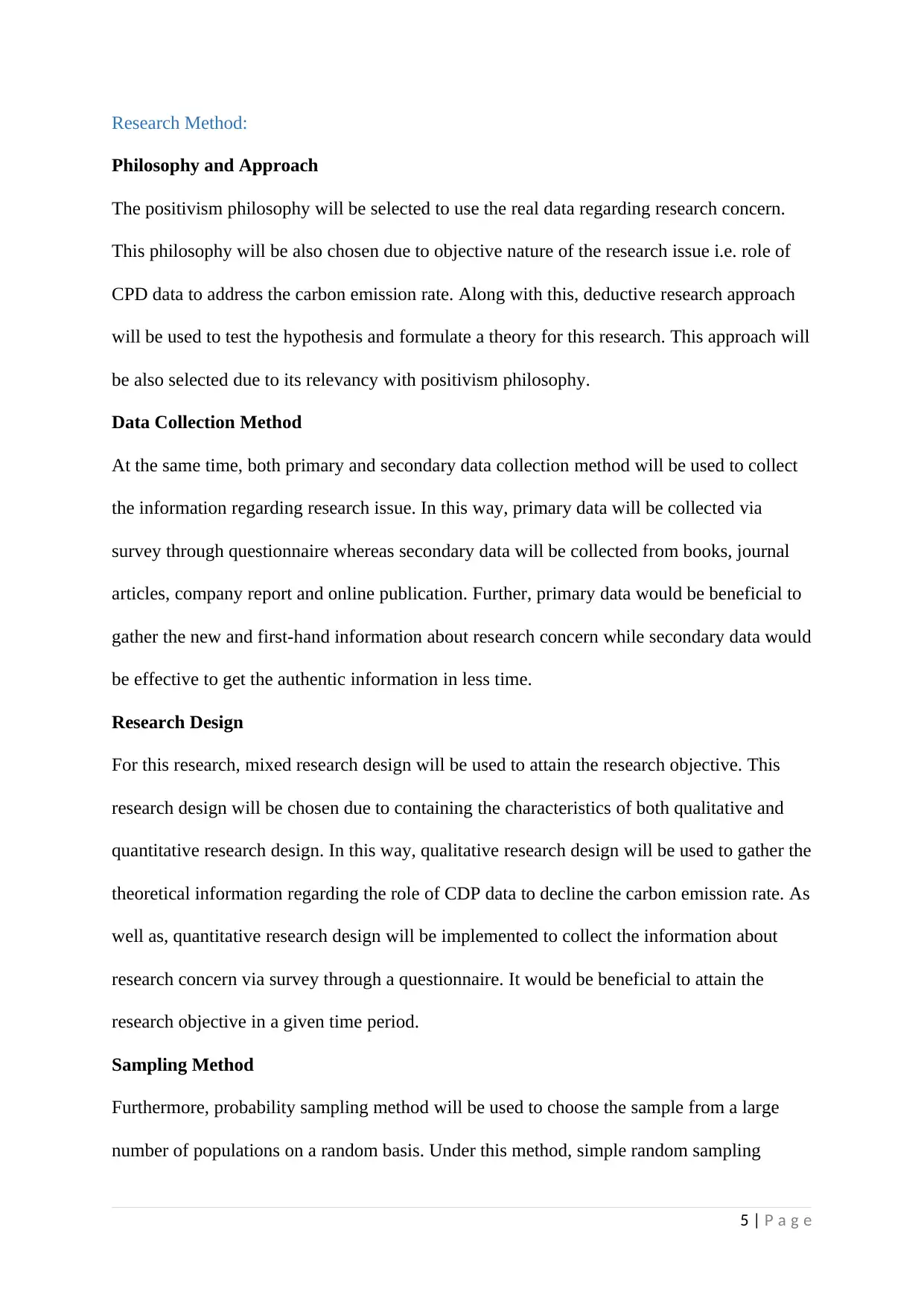
Research Method:
Philosophy and Approach
The positivism philosophy will be selected to use the real data regarding research concern.
This philosophy will be also chosen due to objective nature of the research issue i.e. role of
CPD data to address the carbon emission rate. Along with this, deductive research approach
will be used to test the hypothesis and formulate a theory for this research. This approach will
be also selected due to its relevancy with positivism philosophy.
Data Collection Method
At the same time, both primary and secondary data collection method will be used to collect
the information regarding research issue. In this way, primary data will be collected via
survey through questionnaire whereas secondary data will be collected from books, journal
articles, company report and online publication. Further, primary data would be beneficial to
gather the new and first-hand information about research concern while secondary data would
be effective to get the authentic information in less time.
Research Design
For this research, mixed research design will be used to attain the research objective. This
research design will be chosen due to containing the characteristics of both qualitative and
quantitative research design. In this way, qualitative research design will be used to gather the
theoretical information regarding the role of CDP data to decline the carbon emission rate. As
well as, quantitative research design will be implemented to collect the information about
research concern via survey through a questionnaire. It would be beneficial to attain the
research objective in a given time period.
Sampling Method
Furthermore, probability sampling method will be used to choose the sample from a large
number of populations on a random basis. Under this method, simple random sampling
5 | P a g e
Philosophy and Approach
The positivism philosophy will be selected to use the real data regarding research concern.
This philosophy will be also chosen due to objective nature of the research issue i.e. role of
CPD data to address the carbon emission rate. Along with this, deductive research approach
will be used to test the hypothesis and formulate a theory for this research. This approach will
be also selected due to its relevancy with positivism philosophy.
Data Collection Method
At the same time, both primary and secondary data collection method will be used to collect
the information regarding research issue. In this way, primary data will be collected via
survey through questionnaire whereas secondary data will be collected from books, journal
articles, company report and online publication. Further, primary data would be beneficial to
gather the new and first-hand information about research concern while secondary data would
be effective to get the authentic information in less time.
Research Design
For this research, mixed research design will be used to attain the research objective. This
research design will be chosen due to containing the characteristics of both qualitative and
quantitative research design. In this way, qualitative research design will be used to gather the
theoretical information regarding the role of CDP data to decline the carbon emission rate. As
well as, quantitative research design will be implemented to collect the information about
research concern via survey through a questionnaire. It would be beneficial to attain the
research objective in a given time period.
Sampling Method
Furthermore, probability sampling method will be used to choose the sample from a large
number of populations on a random basis. Under this method, simple random sampling
5 | P a g e
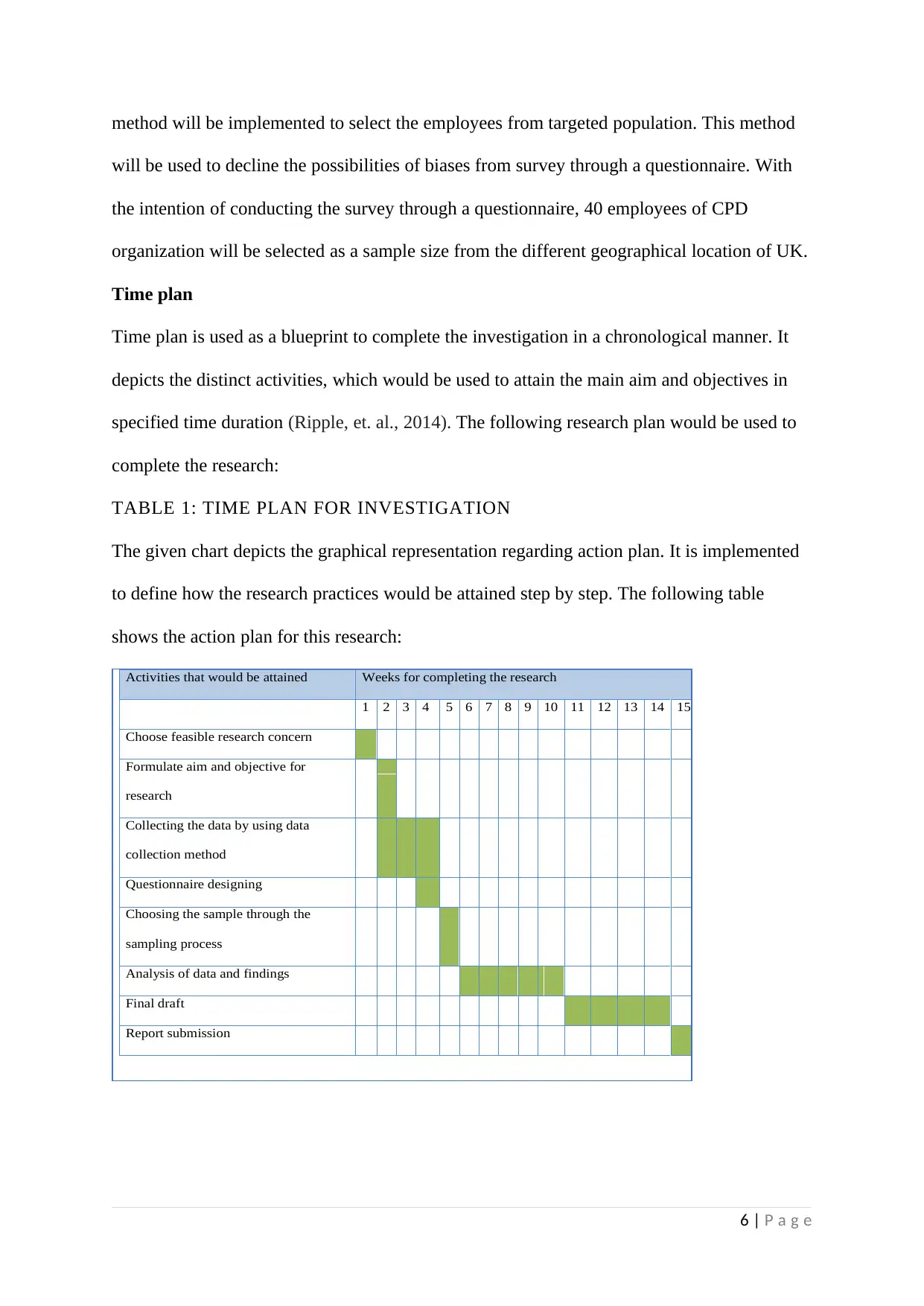
method will be implemented to select the employees from targeted population. This method
will be used to decline the possibilities of biases from survey through a questionnaire. With
the intention of conducting the survey through a questionnaire, 40 employees of CPD
organization will be selected as a sample size from the different geographical location of UK.
Time plan
Time plan is used as a blueprint to complete the investigation in a chronological manner. It
depicts the distinct activities, which would be used to attain the main aim and objectives in
specified time duration (Ripple, et. al., 2014). The following research plan would be used to
complete the research:
TABLE 1: TIME PLAN FOR INVESTIGATION
The given chart depicts the graphical representation regarding action plan. It is implemented
to define how the research practices would be attained step by step. The following table
shows the action plan for this research:
Activities that would be attained Weeks for completing the research
1 2 3 4 5 6 7 8 9 10 11 12 13 14 15
Choose feasible research concern
Formulate aim and objective for
research
Collecting the data by using data
collection method
Questionnaire designing
Choosing the sample through the
sampling process
Analysis of data and findings
Final draft
Report submission
6 | P a g e
will be used to decline the possibilities of biases from survey through a questionnaire. With
the intention of conducting the survey through a questionnaire, 40 employees of CPD
organization will be selected as a sample size from the different geographical location of UK.
Time plan
Time plan is used as a blueprint to complete the investigation in a chronological manner. It
depicts the distinct activities, which would be used to attain the main aim and objectives in
specified time duration (Ripple, et. al., 2014). The following research plan would be used to
complete the research:
TABLE 1: TIME PLAN FOR INVESTIGATION
The given chart depicts the graphical representation regarding action plan. It is implemented
to define how the research practices would be attained step by step. The following table
shows the action plan for this research:
Activities that would be attained Weeks for completing the research
1 2 3 4 5 6 7 8 9 10 11 12 13 14 15
Choose feasible research concern
Formulate aim and objective for
research
Collecting the data by using data
collection method
Questionnaire designing
Choosing the sample through the
sampling process
Analysis of data and findings
Final draft
Report submission
6 | P a g e
⊘ This is a preview!⊘
Do you want full access?
Subscribe today to unlock all pages.

Trusted by 1+ million students worldwide

From the above table, it could be discussed that data gathering process and findings of
research would take more time as compared to other activities, which will be performed
during the research.
7 | P a g e
research would take more time as compared to other activities, which will be performed
during the research.
7 | P a g e
Paraphrase This Document
Need a fresh take? Get an instant paraphrase of this document with our AI Paraphraser
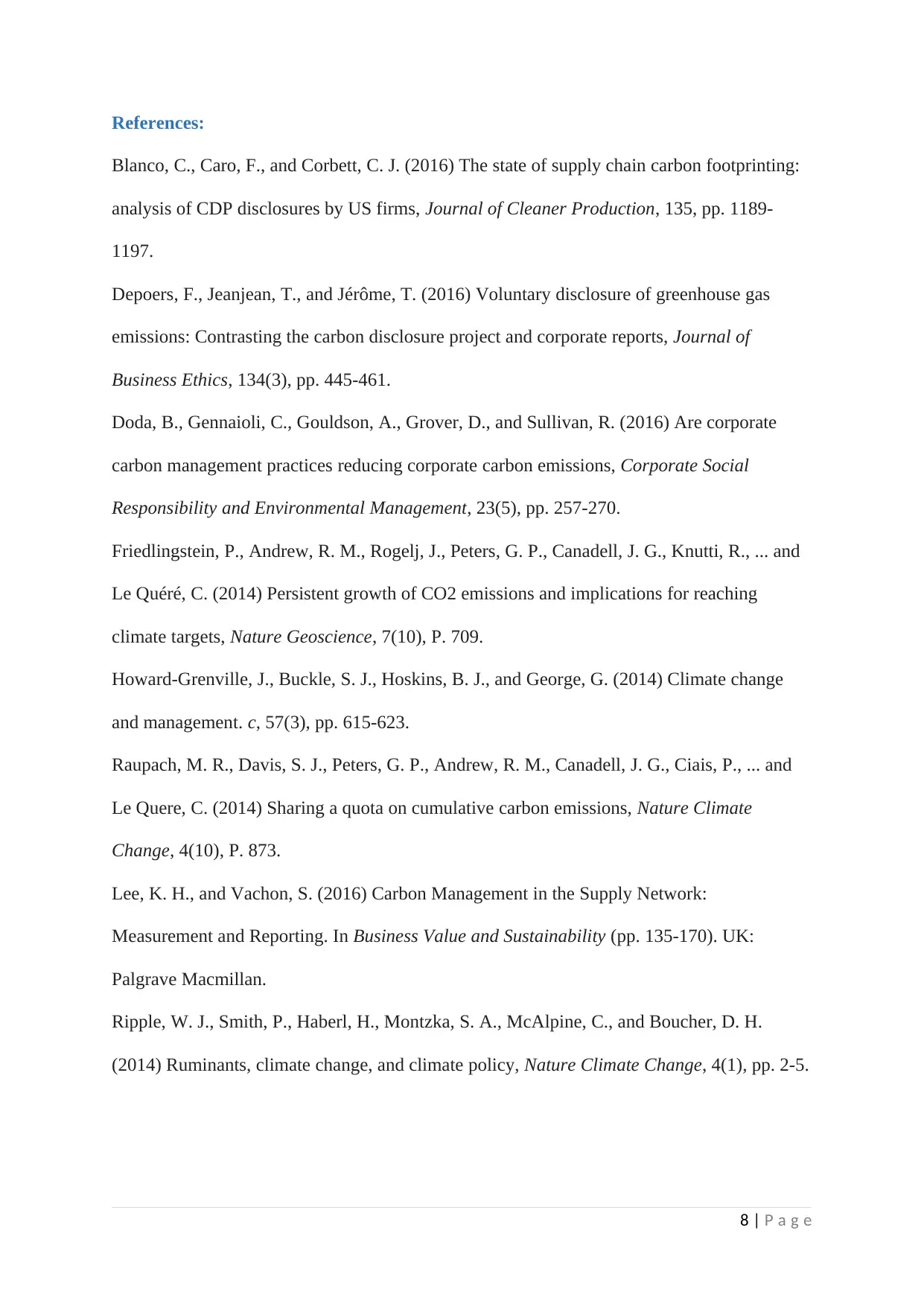
References:
Blanco, C., Caro, F., and Corbett, C. J. (2016) The state of supply chain carbon footprinting:
analysis of CDP disclosures by US firms, Journal of Cleaner Production, 135, pp. 1189-
1197.
Depoers, F., Jeanjean, T., and Jérôme, T. (2016) Voluntary disclosure of greenhouse gas
emissions: Contrasting the carbon disclosure project and corporate reports, Journal of
Business Ethics, 134(3), pp. 445-461.
Doda, B., Gennaioli, C., Gouldson, A., Grover, D., and Sullivan, R. (2016) Are corporate
carbon management practices reducing corporate carbon emissions, Corporate Social
Responsibility and Environmental Management, 23(5), pp. 257-270.
Friedlingstein, P., Andrew, R. M., Rogelj, J., Peters, G. P., Canadell, J. G., Knutti, R., ... and
Le Quéré, C. (2014) Persistent growth of CO2 emissions and implications for reaching
climate targets, Nature Geoscience, 7(10), P. 709.
Howard-Grenville, J., Buckle, S. J., Hoskins, B. J., and George, G. (2014) Climate change
and management. c, 57(3), pp. 615-623.
Raupach, M. R., Davis, S. J., Peters, G. P., Andrew, R. M., Canadell, J. G., Ciais, P., ... and
Le Quere, C. (2014) Sharing a quota on cumulative carbon emissions, Nature Climate
Change, 4(10), P. 873.
Lee, K. H., and Vachon, S. (2016) Carbon Management in the Supply Network:
Measurement and Reporting. In Business Value and Sustainability (pp. 135-170). UK:
Palgrave Macmillan.
Ripple, W. J., Smith, P., Haberl, H., Montzka, S. A., McAlpine, C., and Boucher, D. H.
(2014) Ruminants, climate change, and climate policy, Nature Climate Change, 4(1), pp. 2-5.
8 | P a g e
Blanco, C., Caro, F., and Corbett, C. J. (2016) The state of supply chain carbon footprinting:
analysis of CDP disclosures by US firms, Journal of Cleaner Production, 135, pp. 1189-
1197.
Depoers, F., Jeanjean, T., and Jérôme, T. (2016) Voluntary disclosure of greenhouse gas
emissions: Contrasting the carbon disclosure project and corporate reports, Journal of
Business Ethics, 134(3), pp. 445-461.
Doda, B., Gennaioli, C., Gouldson, A., Grover, D., and Sullivan, R. (2016) Are corporate
carbon management practices reducing corporate carbon emissions, Corporate Social
Responsibility and Environmental Management, 23(5), pp. 257-270.
Friedlingstein, P., Andrew, R. M., Rogelj, J., Peters, G. P., Canadell, J. G., Knutti, R., ... and
Le Quéré, C. (2014) Persistent growth of CO2 emissions and implications for reaching
climate targets, Nature Geoscience, 7(10), P. 709.
Howard-Grenville, J., Buckle, S. J., Hoskins, B. J., and George, G. (2014) Climate change
and management. c, 57(3), pp. 615-623.
Raupach, M. R., Davis, S. J., Peters, G. P., Andrew, R. M., Canadell, J. G., Ciais, P., ... and
Le Quere, C. (2014) Sharing a quota on cumulative carbon emissions, Nature Climate
Change, 4(10), P. 873.
Lee, K. H., and Vachon, S. (2016) Carbon Management in the Supply Network:
Measurement and Reporting. In Business Value and Sustainability (pp. 135-170). UK:
Palgrave Macmillan.
Ripple, W. J., Smith, P., Haberl, H., Montzka, S. A., McAlpine, C., and Boucher, D. H.
(2014) Ruminants, climate change, and climate policy, Nature Climate Change, 4(1), pp. 2-5.
8 | P a g e
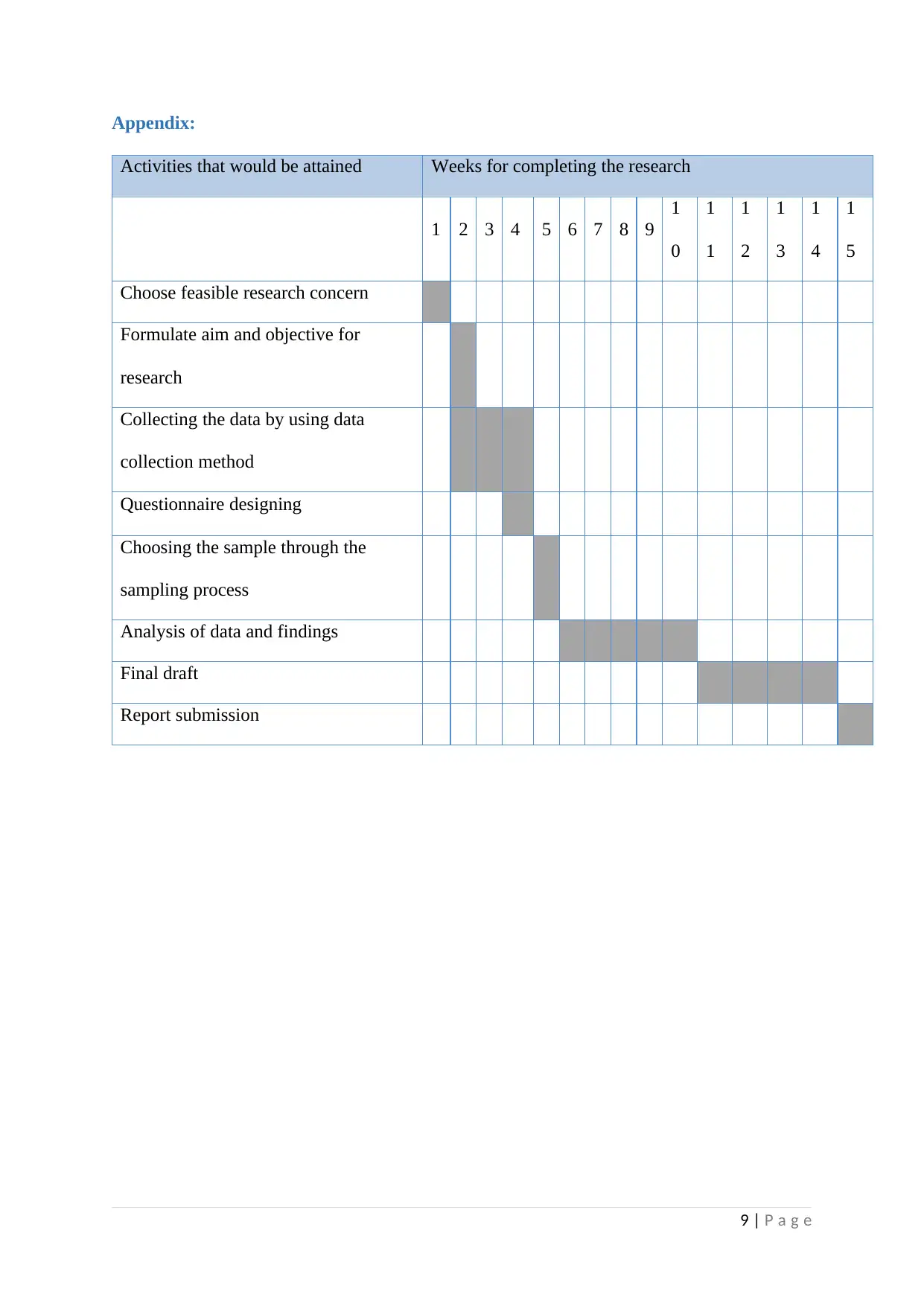
Appendix:
Activities that would be attained Weeks for completing the research
1 2 3 4 5 6 7 8 9
1
0
1
1
1
2
1
3
1
4
1
5
Choose feasible research concern
Formulate aim and objective for
research
Collecting the data by using data
collection method
Questionnaire designing
Choosing the sample through the
sampling process
Analysis of data and findings
Final draft
Report submission
9 | P a g e
Activities that would be attained Weeks for completing the research
1 2 3 4 5 6 7 8 9
1
0
1
1
1
2
1
3
1
4
1
5
Choose feasible research concern
Formulate aim and objective for
research
Collecting the data by using data
collection method
Questionnaire designing
Choosing the sample through the
sampling process
Analysis of data and findings
Final draft
Report submission
9 | P a g e
⊘ This is a preview!⊘
Do you want full access?
Subscribe today to unlock all pages.

Trusted by 1+ million students worldwide
1 out of 9
Related Documents
Your All-in-One AI-Powered Toolkit for Academic Success.
+13062052269
info@desklib.com
Available 24*7 on WhatsApp / Email
![[object Object]](/_next/static/media/star-bottom.7253800d.svg)
Unlock your academic potential
Copyright © 2020–2025 A2Z Services. All Rights Reserved. Developed and managed by ZUCOL.





